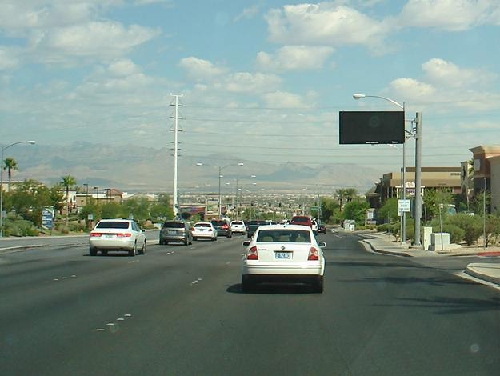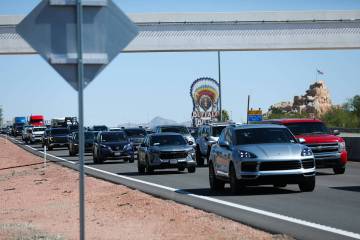For four years, message board said nothing
We do our best to take note of trouble spots across the Las Vegas Valley, but it takes readers in all different parts of town to notice not only bad paving but quirky things too. Ray did so this week and even took a photo of the issue. So, we lead with Ray and his accompanying photograph.
About four years ago, someone constructed an electronic sign board over Eastern Avenue between Horizon Ridge Parkway and Coronado Center Drive. And for four years, it has sat there fat, dumb and happy saying nothing. Who had this ugly thing constructed and why has it since been sitting there unused?
Ray's correct on the time frame and also on the fact that it just sits there. According to the folks at the Freeway and Arterial System of Transportation (FAST), the agency that posts warnings on electronic message boards, the city of Henderson believed this to be necessary to advise motorists of traffic tie-ups on Eastern. They secured a federal grant and built the sign. The problem is, Eastern is not equipped with cameras, so transportation experts have no way to check out the traffic flow and subsequently notify drivers. FAST expects to install cameras in the future. At that time, the sign might look to be a slightly more intelligent project.
I'd like to briefly revisit Bill's rant from a couple weeks ago. His beef in a nutshell: Sometimes the left-turn arrow is on along with green light for one direction. Oncoming traffic waits. Arrow off, both directions go straight. Then, first green goes off, and opposing left-turn green arrow goes on. Bill suggested that anyone who believes this process works is "cuckoo."
So, I visited the FAST facility and talked with the people in charge of traffic signals. It's called a "lead-lag" system, meaning some left-turn arrows turn green in the early stages of the green light for through traffic. In that case, the left-turn light for opposing traffic will turn green toward the end of the through traffic's green light. The theory is that this system allows "platoons" of motorists to move through several intersections without hitting a red light because the green light cycle is longer. They claim this works because of the way the signals are synchronized. The platoon, or grouping, of vehicles in one direction will arrive to the intersection later than the group headed in the opposite direction.
"It's an art and it's a science," said Brian Hoeft, assistant director of FAST. "We're not just rolling the dice."
Donald is curious: Why don't they adjust traffic signals when roads are reduced to one lane for construction? Sometimes you have to wait for three or four cycles to get through.
Fortunately for readers, I spent a lot of time with the signal people this week. As you can probably tell by now, I brought along with me a bunch of your questions. So Donald, they do, or at least try, to adjust them. Sometimes it's difficult when it's a less traveled road that is under construction. For example, traffic along Las Vegas Boulevard will back up much more quickly than, say, Pebble Road. The other problem is that the entity in charge of the project doesn't always pass along the information to FAST.
If FAST has a camera on the problem, technicians work on it.
Here's an example: When a segment of the Las Vegas Beltway is closed for construction at Interstate 15, cars are detoured across Las Vegas Boulevard and then back onto the Beltway. Some motorists missed the signs and ended up on I-15 north. Of course they all exited on Russell Road to turn around, causing massive backups on Russell. Seeing the problem on camera, FAST lengthened the light.
An anonymous reader asks: The manhole covers on Nellis Boulevard between Sam's Town and Las Vegas Boulevard are not flush with the road. Do they plan on leveling them?
Residents all over the valley can sympathize with this gentleman. First off, yes, Nellis will be leveled off. As far as I understand, here is why this happens. As we've discussed before, when roads require repaving the final layer as asphalt can't be applied until the temperature warms up. So, when the initial work is done, crews have the option of doing the manholes first, which leaves a violent bump in the road, or leveling them off after the last asphalt application, which leaves motorists wondering why the heck the recently paved road is being torn up again.
Obviously the weather is now warm enough to complete the work, but there are so many paving projects it will likely take time to get to them all.
If you have a question, tip or tirade, call Adrienne Packer at (702) 387-2904, or send an e-mail to roadwarrior@reviewjournal.com. Include your phone number.
The ramp from eastbound Las Vegas Beltway to Las Vegas Boulevard will be closed from 10 p.m. Thursday to 5 a.m. Friday while a barrier rail is installed.
The ramp from Interstate 15 to the Las Vegas Beltway west and the Las Vegas Boulevard onramp to the westbound beltway will be closed during nighttime hours through 5 a.m. Friday.
On Blue Diamond Road in each direction at I-15, traffic will be rerouted to a temporary onramp to I-15 north. This detour will remain in effect until October.
Sunset Road at Dean Martin Road is closed through August.
Various lanes will be closed on Interstate 15 between the Spaghetti Bowl and Cheyenne Avenue from 9 p.m. Thursday until 5 a.m. Friday for striping.
Expect lane closures and restrictions on Volunteer Boulevard and Executive Airport Drive as crews construct a two-lane, paved roadway. The project is expected to be completed in October.
Las Vegas Review-Journal

















